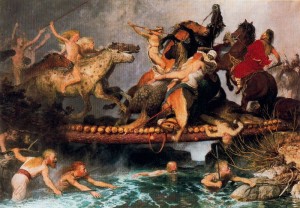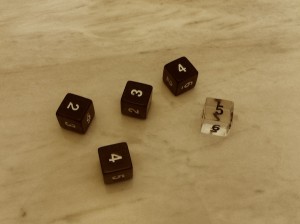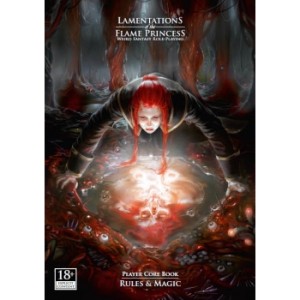Expanding on the previous idea of modeling combat between two foes with a single roll (monologic combat) rather than a pair of rolls, here is an extended example.
Dramatis personae:
- Magic-user (PC, level 2, unarmored, dagger, fire wand, HD 1+1, HP 4)
- Fighter (PC, level 2, armor 3, sword, shield, crossbow, HD 2+1, HP 8)
- Thief (PC, level 2, armor 1, crossbow, dagger, sword, HD 2, HP 7)
- Torchbearer (PC magic-user’s retainer, level 0, armor 1, lantern, dagger, HD 1, HP 4)
- 4 goblins (monsters, armor 1, short bow, cleaver sword, HD 1-1, HP 3)
- A six-legged giant lizard the size of an ox (monster, armor 2, HD 5, HP 20)
- Goblin beast master captain (monster, armor 3, axe, whip, HD 3, HP 11)
The scene: a cavern bisected by a crevasse with a narrow stone bridge of ancient provenance. An underground river flows quick and cold, 100 feet below the bridge. The player characters wish to take the bridge and proceed to the tunnel leading out of the cavern’s far side.
Lantern light and a snarling giant lizard make it so neither side is surprised (because I want this example to be less of a one-sided engagement). Surprise could be determined using the standard d6 per side method. I am also going to decide that the goblins are out for blood, but in a real game I would probably roll for reaction.

Bocklin – Fighting on a bridge (source)
Initiative is important to determine in this system, because going first means you can choose your engagement (if you are not already occupied). Retreating or disengaging requires a successful combat action. To determine if initiative is gained, each player makes a combat check versus a threat number that the referee determines by ruling to represent the opposing forces. In this case, it is 3 (based on the leader’s level; note that this could change based on balance of forces as the skirmish progresses), leading to a target number of 13. Any player that makes this roll (1d20 + combat bonus) acts before the monsters. Otherwise, after. Spell casting must be declared before the initiative die is rolled, and in that case no movement may be taken. Spells resolve at the end of the round. The magic-user elects to begin casting a spell, charm person, against the goblin captain, while remaining in the cavern entrance behind the other party members. (The magic-user’s other prepared spell is hold portal). The fighter and thief succeed in their initiative check. So the order is: fighter, thief, monsters, magic-user, torchbearer (who acts on the magic-user’s count).
The thief chooses to move to the side and take aim at the lizard. Next round, he will be able to take a shot with backstab advantages since the lizard is not yet in melee (a rule I just made up). The fighter (armed with sword and shield) is going to charge across the bridge and take the fight to the goblin archer brigade. Despite winning initiative, the fighter is still going to need to defend against the goblin arrows this round (consuming her combat action), given that missile weapons beat melee weapons (if she was using a missile weapon, she would have a chance to inflict damage as well, but in this case she will not). However, her shield will grant her a +2 combat bonus since she is facing arrows. The goblin archers are ganging up (+1 each, up to +4 max; it seems like these are the “helping” rules). So the final roll is 1d20 + 3 (fighter combat bonus) + 2 (fighter shield) = 1d20 + 5 versus 10 + 0 (goblin combat bonus) + 3 (gang up) = target number 13. Fighter rolls 9, which is 14, and thus defends successfully against the volley. (Had it hit, the gang up bonus would have applied to damage as well.) The fighter’s action resolves and she is now in melee with the goblins, but has already made her combat roll. Thus, the goblins take no damage, but are still in melee and will not be able to fire their missile weapons without disengaging. They have also already used their action and thus will be passed over on the monster count.
Next is the thief, who moves and aims. (A stealth check might be permitted here to make it so that the thief cannot be targeted by enemies until an action triggers, but I am not going to worry about that now.) Now the monsters act. This is just the lizard and the captain, as the archers have already made their attack. Further, the bridge is currently threatened by the fighter in melee with the archers, so advance over the bridge is impossible. The fighter is surrounded in the front by mooks scrambling to hold the fighter at bay, so the referee rules that the lizard cannot enter the melee (not having any reach attacks). However, the captain has a whip, which is a reach weapon, and so will attempt to grapple the fighter at reach and pull her prone so that the goblins may attempt to overwhelm her. The fighter makes another defense roll, with no modifiers applying, of 1d20 + 3 versus 10 + 3 (captain HD) = 13. There is no chance of the fighter damaging the captain, both because the fighter has already spent her action and because she is not wielding a weapon with reach threat and is constrained by the archers. She rolls badly, 5 (+3 = 8), and is pulled prone under the stamping nasty feet of the small goblin horde. The lizard can’t do anything and so retains its combat roll for potential reaction (which will be lost if nothing triggers it by the end of the round).
Finally, the magic-user and torchbearer act. The chanting ceases and the spell goes off. Traditionally this would require the goblin captain to make a saving throw versus spells, which is what I am going to go with here, but in some ways I might prefer a magic-user roll versus target magic defense (which should be lower than the combat defense number based on HD unless the target is magical in some way). But whatever, the referee is just going to break the elegance of the system and make a saving throw for the goblin captain, because I have not thought enough about this part of the system and do not want to accidentally homogenize spell casting and physical combat. The captain rolls 18, making the save. Unfortunate, but it happens. The torchbearer is doing nothing, cowering next to the magic-user, maintaining the light source and reserving his action for potential self-defense.
Next round. If the fighter was not already exposed up in melee, the magic-user might opt to spend the hold portal spell for a blast of acid maleficence, but in this case that is deemed too dangerous, so no spell casting is declared. Initiative is rolled. The fighter is prone and so gains no combat bonus to initiative. (Another discovered rule!) The fighter fails and will act after the monsters, the magic-user and thief succeed, so they will act first. The magic-user defers, not having a spell to cast, and being too far away to throw a dagger (referee ruling). The thief takes the backstab shot (had the lizard been in melee by this point, the shot would no longer have backstab bonuses and instead would be subject to whatever penalties are involved with shooting into melee; probably random target determination). The thief’s combat roll is 1d20 + 2 (combat bonus) + 4 (backstab) = +6 versus 10 + 5 (lizard threat level) = 15. The roll is 16, +6 is 22, which is enough to hit, dealing 1d6 + 1d6 (backstab bonus) + 1d6 (hit margin more than 4) – 2 (lizard armor) = 4 + 5 + 4 – 2 = 11 damage. The lizard is now at 9 HP. (Yes, traditionally the backstab is a multiplier, but I prefer additional damage dice. The overkill bonus is another new rule.) The lizard rears up in agony.
Monsters turn. Still prone, the fighter remains dangerous but looses her attack bonus. The goblins drop their bows and set upon her with cleavers, hacking and chopping. The fighter rolls 1d20 to defend (no bonuses, because prone), versus target number of 10, four times (the monsters are opting for separate attacks rather than ganging up). First roll is 11, successfully defending. Fighter is opting not to count this as her action so that she can attempt to regain her footing and thus get back her attack bonus when her turn comes around. Second three rolls are not so lucky however; 3, 7, and 9. The fighter is thus damaged by three goblins, 1d6 each, for 5, 4, and 6 damage. Her heavy armor subtracts 3 from each of those rolls, leading to 2 + 1 + 3 = 6 damage, leaving her with 2 HP. Can the captain or lizard get off an attack here? I am going to say no, but melee threat rules probably need to be more formalized, because I could see it going either way. Since the captain and lizard are still bottlenecked, their actions are held for reactivity.
Now the fighter acts. She could try to fight from prone (no attack bonus, no fancy maneuvers, no potential cleave), or use the combat action to stand up. Had the goblin mooks not already used their combat roll to stomp all over her, this would have the potential of damaging her, but in this case there is no chance of damage on either side and the roll is just to see if she can regain her footing. 1d20 + 0 (remember, no attack bonus because prone) versus 10 (goblin threat level). The roll is 12, and she throws off the chopping and cackling goblins, ready for another round (but a bit worn down, at only 2 HP).
Round three. Magic-user starts to cast maleficence at the captain (only a single target, limiting overall damage potential, but safer). Fighter and magic-user succeed on initiative. Thief fails. So the order is fighter, magic-user (torchbearer), monsters, thief. The fighter attacks the mooks surrounding her, and the combat roll is 13 + 3 (attack bonus) for 16, which is enough to hit a goblin (target number being 10, the 1-1 HD not contributing). Hit margin is more than 4, adding an extra die of damage. Damage roll is 5 + 2, running one goblin through, and allowing another attack against a nearby goblin if desired, with a +1 bonus (cleave). Thus another combat roll is made, this time 5 + 3 (for attack bonus) + 1 (for cleave) = 9, which fails, resulting in the goblin hitting the fighter, d6 damage = 5 – 3 (for fighter armor 3), dealing 2 point of damage to the fighter and slaying her. The three remaining goblins hoot with glee. The magic-user’s spell is still going even though he won initiative, and will resolve at the end of the round.
Now the monsters go. The mooks and lizard will charge across the bridge and attempt to get to the magic-user before the spell goes off. Though the thief lost initiative, he is able to take a shot at the leading goblin since he has a missile weapon (and is not in any danger doing so because all the enemies are currently only armed with melee weapons and so cannot shoot back). He hits and kills one of the charging goblins, who plummets into the chasm with a shriek. Two mooks, a wounded lizard, and an unwounded captain (who stayed on the far side of the chasm) remain. The referee rules that the charge by the monsters was slowed by the successful arrow shot, and thus they are not able to attack this round, or disrupt the spell (some formalization of these movement rules would probably be welcome, as this feels a bit arbitrary to me). The spell goes off and the captain fails his save, taking the full 2d6 acid damage (which ignores armor). The damage roll is lucky, 5 + 6 = 11, burning the face and half of the chest off of the captain, leaving a smoking corpse with protruding ribs and a sickening smell. In their bloodlust, the mooks don’t notice their leader fall (otherwise, they would need to pass a morale check at the beginning of the next round).
Back to initiative. The thief succeeds, the magic-user fails, the fighter player takes over the torchbearer (and fails). So the order is thief, monsters, magic-user, torchbearer. The thief takes this opportunity to hide, and climb partly up the walls of the cavern. He makes his stealth (or hide, whatever) check. (Hiding would not have been an option had he been in melee or if the captain on the other side of the chasm was still alive.) The monsters act, only two able to bring offense to bear on the magic-user given the narrow confines of the passage. The referee dices to see which, and it is one mook and the lizard. The magic user rolls defense, brandishing a dagger, attempting frantically to keep the monsters away. The player opts to not attempt a counterattack, as that would consume the magic-user’s action, and the player wants to attempt to break from melee and flee. Unfortunately, the two rolls go badly for the magic-user, 3 and 9, and both enemies hit. The magic-user is unarmored, and takes the full brunt of gnashing lizard teeth and goblin cleaver, for 3 + 4 = 7 damage, which kills him.
The torchbearer attempts to flee, but fails his combat roll and is cut down by cleavers during the next round (which I won’t bother detailing). The thief waits above as the monsters feast on the corpses, and then slinks away once the coast is clear. And so ends this example combat.
Note that one could easily swap in a different system for determining surprise (or many other aspects of this combat), without substantively affecting the underlying dynamics. For example, a roll less than or equal to dexterity could be used for initiative rather than attack bonus versus monster threat level.
I am not entirely satisfied with how ranged combat was handled here. Should the goblins have automatically been able to force defense on the fighter? Similarly, should the thief have been able to take a bow shot as the mooks were crossing the bridge? It makes sense fictionally, but could also be represented with initiative bonuses, perhaps. In that case though, the group of monsters should probably be partitioned into two groups, ranged and non-ranged, which starts to increase the complexity in a way that seems like might be a hassle at the table. Distances seem important for the charging actions, and I am not sure the way I modeled that above is best.
The first melee attack of the goblins against the fighter could perhaps have used helping rules, which would have used a single combat roll with bonuses and extra damage on a hit. This might make sense to overcome armor, but I would want to make sure that expected damage (taking everything into consideration) does not yield a consistently optimal strategy. I think that is beyond the scope of this post, though.






